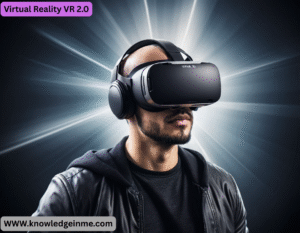Virtual Reality VR 2.0 Virtual Reality has come a long way since its early days, and VR 2.0 represents the next major leap in immersive experiences. Building on the foundations of first-generation VR, this new wave introduces advancements in hardware, software, and user interaction, making virtual worlds more realistic, accessible, and impactful than ever before.
Key Features of VR 2.0
- Higher Resolution & Wider Field of View (FOV)
- 4K+ per eye displays reduce the “screen-door effect” for sharper visuals.
- Ultra-wide FOV (150°+) enhances immersion by mimicking natural human vision.
Advanced Eye & Face Tracking
- Foveated rendering improves performance by focusing GPU power only where the user is looking.
- Emotion & expression tracking via built-in cameras enables realistic avatars in social VR.
Haptic Feedback & Full-Body Interaction
- Gloves, suits, and advanced controllers provide realistic touch sensations.
- Force feedback simulates weight, texture, and resistance in virtual objects.
Standalone & Wireless Dominance
- Powerful mobile chipsets (e.g., Snapdragon XR3) eliminate the need for a PC or console.
- Wi-Fi 6E & 5G enable low-latency cloud-based VR experiences.
Mixed Reality (MR) Integration
- Passthrough AR+VR blending allows seamless transitions between real and virtual worlds.
- Depth-sensing cameras improve environment mapping for mixed-reality apps.
AI-Powered VR Experiences
- Procedural generation creates dynamic, ever-changing virtual worlds.
Social & Enterprise Applications
- Metaverse-ready platforms (Meta Horizon, Apple Vision Pro ecosystem).
- VR workspaces with multi-monitor setups, 3D design tools, and virtual meetings.
Leading VR 2.0 Devices (2024-2025)
- Apple Vision Pro – High-end mixed reality with ultra-sharp displays.
- Valve Deckard (Rumored) – PC VR with wireless & standalone modes.
- Sony PlayStation VR2 – Console VR with eye tracking & haptics.
- Pimax Crystal & Varjo XR-4 – Premium PC VR for professionals.
Challenges Ahead
- Battery life for wireless headsets remains a limitation.
- Motion sickness still affects some users, despite improvements.
The Future of VR 2.0
- As AI, 5G, and haptics continue to evolve, VR 2.0 will blur the line between physical and digital realities even further. Expect:
- Photorealistic avatars for work and social interaction.
- Neural interfaces (like Meta’s EMG wristband) for thought-based controls.
Next Gen Display Technology
Micro-OLED & Mini-LED Panels
- Micro-OLED (used in Apple Vision Pro) offers 4K+ per eye, true blacks, and ultra-fast response times.
- Mini-LED backlighting improves contrast (100,000:1) for HDR experiences.
- Future: Nano LED and laser beam scanning could enable retina-level resolution (>60 PPD).
Varifocal & Light Field Displays
- Light field displays (e.g., Nvidia’s research) simulate natural depth perception without glasses.
2. AI & Machine Learning in VR 2.0
AI-Generated Virtual Worlds
- Procedural generation (like NVIDIA Omni verse) creates infinite, dynamic environments.
- Neural radiance fields (NERF) turn 2D photos into 3D scenes in real time.
Smart NPCs & Natural Interaction
- AI-driven characters (powered by LLMs like GPT-4o) enable lifelike conversations.
- Voice recognition + lip sync (e.g., Meta’s Voice SDK) for realistic social VR.
AI Upscaling & Performance Optimization
- DLSS-like rendering boosts frame rates without quality loss.
- Predictive movement algorithms reduce motion-to-photon latency.
3. Haptics & Sensory Immersion
Advanced Force Feedback
- Ultrasonic mid-air haptics (e.g., Ultra Leap) let you “feel” virtual objects without gloves.
Neuro-Haptic Feedback
- EMG wristbands (like Meta’s research) detect subtle finger movements for natural input.
- Future: Direct neural stimulation (early-stage research) could simulate touch without physical contact.
4. Mixed Reality (MR) & Passthrough AR
Depth-Sensing & Scene Understanding
- LiDAR + RGB cameras (Apple Vision Pro) enable precise real-world mapping.
- Semantic understanding – VR systems recognize objects (e.g., “this is a table, this is a wall”).
Seamless AR/VR Switching
- Magic Leap 2 & Meta Quest 3 allow instant transitions between VR and AR modes.
- Future: Holographic light field displays could merge real and virtual light rays.
5. Enterprise & Professional Use Cases
Medical & Surgical Training
- VR 2.0 + haptic gloves simulate surgeries with realistic tissue resistance.
- AI-guided diagnostics in virtual 3D scans.
Architecture & Engineering
- Real-time 3D CAD collaboration in VR (e.g., Autodesk VRED).
- Digital twins of factories, cities, and products for simulation.
Military & Aviation
- Pilot training with ultra-low latency and photorealistic environments.
- Tactical VR simulations for soldiers with full-body tracking.
6. The Social & Metaverse Evolution
Hyper-Realistic Avatars
- Unreal Engine Meta Humans + iPhone Face ID scanning = lifelike digital doubles.
- Emotion tracking (via eye/face cameras) makes avatars express real smiles and frowns.
Persistent Virtual Worlds
- Decentra land, Meta Horizon Worlds, and Somnium Space evolve into always-on 3D social hubs.
- Blockchain-based asset ownership (NFTs for VR items, land, and wearables).
7. Challenges & Unsolved Problems
Battery & Thermal Limits
- Standalone headsets still last only 2-3 hours under heavy use.
- Future solutions: Graphene batteries, wireless charging, or cloud-streamed VR.
Motion Sickness & Comfort
- Dynamic foveated rendering + 120Hz+ displays help but don’t eliminate it for everyone.
- Vestibular stimulation research (e.g., Galvanic Vestibular Stimulation) may trick the brain into feeling motion.
Ethics & Privacy Concerns
- Eye tracking data reveals attention patterns (valuable to advertisers).
- Deep fake avatars could enable new forms of fraud or harassment.
8. The Future: VR 3.0 & Beyond
Brain-Computer Interfaces (BCI)
- NEURA link, Meta BCI, Open BCI aim for direct brain control of VR.
- Early experiments allow typing with thoughts or “feeling” virtual objects.
Photorealistic VR by 2030
- Path tracing + AI super-resolution could make VR indistinguishable from reality.
- Full sensory immersion (smell, taste, temperature) via wearable tech.
The End of Smartphones
- AR/VR glasses (like Ray-Ban Meta, Apple Vision Pro successors) may replace phones by the 2030s.
- Hardware Revolution: The Engines Powering VR 2.0
Displays: Beyond 4K & Into Light Fields
Micro-OLED vs. Mini-LED
- Micro-OLED (Apple Vision Pro, upcoming Valve headset) offers 4K+ per eye, perfect blacks, and ultra-low persistence.
- Mini-LED backlighting (Varjo XR-4) enables 10,000+ dimming zones for HDR.
- Future: Nano LED (self-emissive, no backlight) and holographic light fields (looking glass displays) could eliminate the vergence-accommodation conflict.
Optics: Pancake Lenses & Varifocal Systems
- Pancake lenses (Meta Quest 3, Pico 5) reduce headset thickness while improving clarity.
- Varifocal displays (Meta’s Half Dome prototypes) dynamically adjust focus, preventing eye strain.
- Electroactive liquid crystal lenses (research stage) could auto-adjust for prescription needs.
C. Tracking & Sensors
- Inside-Out SLAM + LiDAR (Vision Pro) enables sub-millimeter accuracy without external sensors.
- Ultra-wideband (UWB) sensors (rumored in Quest Pro 2) improve controller tracking.
- EMG & Nerve Sensing (CTRL-Labs/Meta wristband) detects finger movements via neural signals.
D. Haptics: The Touch Revolution
- Tesla Suit, BHAPTICS, Sense Glove – Full-body force feedback for training and gaming.
- Ultrasonic & Electro-Tactile (Ultra Leap, Sony’s research) – Mid-air haptics without gloves.
- Future: Direct Neural Haptics (DARPA-funded projects) could simulate touch via brain interfaces.
2. Software & AI: The Brains of VR 2.0
A. AI-Generated Worlds
- Neural Radiance Fields (NERF) – Turns 2D photos into explorable 3D scenes (NVIDIA, LUMA AI).
- Procedural Generation (Unreal Engine 5 Nanite) – Infinite, detailed worlds with no repetition.
- Diffusion Models for VR Avatars – AI instantly generates realistic faces from text prompts.
B. Natural Interaction
- Voice + Gesture + Gaze UI (Apple Vision Pro) replaces controllers in productivity apps.
- AI NPCs with GPT-4o – Lifelike conversations in VR social spaces.
- Emotion Recognition (Affectiva, Apple Face ID) – Avatars mimic your real expressions.





